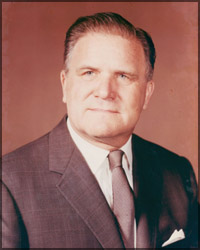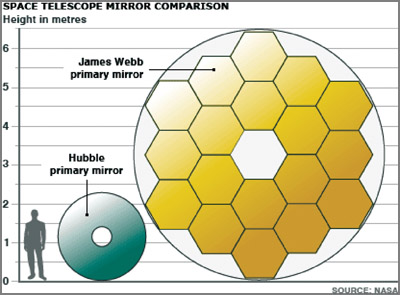 James Webb Space Telescope: James Webb Space Telescope:
The space telescope of tomorrow
Outer
space is a maze of mysteries. Over many years, the untiring efforts of
scientists, engineers, physicists and many other people have contributed
to reveal the truth behind these mysteries and present us a vast
knowledge about the previously unknown. But still, the quest is not
over.
There are greater mysteries left to be solved, and unless the
observation models are improved, even the greatest set of theorists
together with the greatest supercomputer would not be able to resolve
these mysteries.
At the moment giant space tellscopes such as Hubble, Spitzer and
Chandra are giving us magnificent views of outer space. The newest
member into this family of space telescopes is going to be the 'James
Webb Space Telescope', which is expected to overcome many challenges
which the other telescopes couldn't.
The James Webb Space tellescope (JWST) is a planned space infrared
observatory, which is expected to be a significant improvement on the
Hubble Space Telescope which is getting quite old now.
JWST is a group effort between NASA, the European Space Agency and
the Canadian Space Agency. This was initially called the Next Generation
Space Telescope or NGST.
However in 2002, it was renamed after NASA's second administrator,
James E. Webb.
The telescope's launch is planned to take place around June 2013. It
will be launched on an 'Ariane 5' rocket from Guiana Space Centre Kourou,
French Guiana, with a launch mass of approximately 6.2 tonnes.
*** *** *** *** *** *** *** *** *** *** ***
*** *** *** *** *** *** *** ***
Who
is James E Webb?

James Edwin Webb was the second administrator of the National
Aeronautics and Space Administration (NASA), formally established on
October 1, 1958. Many believe that James E. Webb, who ran the space
agency from February 1961 to October 1968, did more for science than
perhaps any other government official and that it is correct that the
Next Generation Space Telescope would be named after him.
*** *** *** *** *** *** *** *** *** *** ***
*** *** *** *** *** *** *** ***
About the telescope
The weight of the JWST is expected to be about half the weight of the
Hubble telescope.
However, its primary mirror is almost six times larger. This is known
as a 6.5 metre diameter beryllium reflector. As this diameter is much
larger than any current launch vehicle, the mirror is made out of 18
hexagonal pieces, which will open up after the telescope is launched.
Since this is an infrared telescope, it must be ensured that the
observations are not affected by infrared emission from the telescope
and instruments themselves.
Therefore, they have designed the entire observatory to be cold and
well-shielded from the Sun so that it can be kept at a low temperature
around 40 Kelvin (233 Celsius).
To achieve this, JWST will include a large metalised fanfold
sunshield, which will open up to block infrared radiation from the Sun,
as well as from the Earth and Moon.
The location of the telescope plays a key role in making this
possible. The telescope will be kept in a point in space called the 'L2
Lagrange Point'.
A Lagrange Point, in simpler terms, is a point where a small object
affected only by gravity can theoretically be stationary relative to two
larger objects. In this case the telescope will be the small object, and
the Sun and Earth will be the two large objects.
Earth will be the two large objects.
Therefore, the shield can be effectively used to avoid solar
radiation. We will look at Lagrange Points in detail, in a later edition
of 'Space Station'.
Several new technologies have been developed for JWST, which include
the folding, segmented primary mirror, ultra-lightweight beryllium
optics, detectors able to record extremely weak signals, microshutters
that enable programmable object selection for the spectrograph, and a
cryocooler for cooling the mid-IR detectors to 7 Kelvin (-266 Celsius).
*** *** *** *** *** *** *** *** *** *** ***
*** *** *** *** *** *** *** ***
Mission
The JWST's scientific mission has four main objectives. The main
objective is to search for light from the first stars and galaxies which
formed in the Universe after the Big Bang.
Secondly, it is expected to study the formation and evolution of
galaxies. Next, it is to be used to understand the formation of stars
and planetary systems and finally it is expected to study planetary
systems and the origins of life.
 The
observatory will begin the science mission, after a commissioning period
of about six months, which will be required to go on with the
explorations up to a minimum of five years. The
observatory will begin the science mission, after a commissioning period
of about six months, which will be required to go on with the
explorations up to a minimum of five years.
The JWST programme is currently in its preliminary design phase which
is known as Phase B. In January 2007 nine of the ten technology
development items in the programme successfully passed a review and they
were considered to have no risk on the programme.
The remaining technology development item, the MIRI cryocooler
completed its technology maturation milestone in April 2007.
This technology review represented the first step in the process that
will ultimately move the programme into Phase C, which is its detailed
design phase. In May 2007 the cost of the project was estimated at about
US$ 4.5 billion.
Aravinda
Dassanayake |
